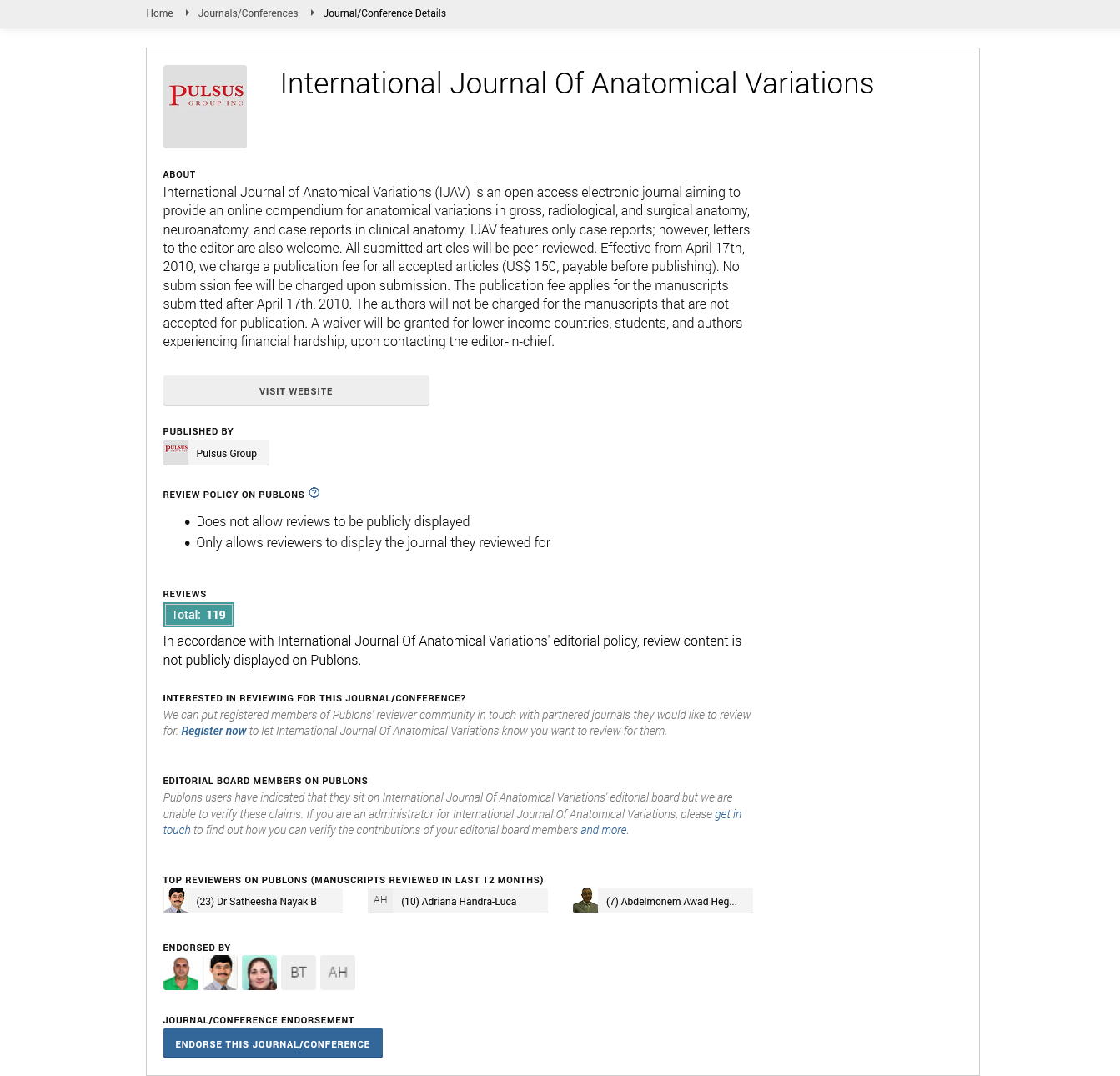Developmental Anomalies of the Inferior Vena Cava and Their Effect on Abdominal and Pelvic Surgery
Received: 02-Jan-2025, Manuscript No. ijav-25-7540; Editor assigned: 04-Jan-2025, Pre QC No. ijav-25-7540 (PQ); Reviewed: 18-Jan-2025 QC No. ijav-25-7540; Revised: 24-Jan-2025, Manuscript No. ijav-25-7540 (R); Published: 31-Jan-2025, DOI: 10.37532/1308-4038.18(1).472
Citation: Ahmad HM. Developmental Anomalies of the Inferior Vena Cava and Their Effect on Abdominal and Pelvic Surgery. Int J Anat Var. 2025;18(1): 713-714.
This open-access article is distributed under the terms of the Creative Commons Attribution Non-Commercial License (CC BY-NC) (http://creativecommons.org/licenses/by-nc/4.0/), which permits reuse, distribution and reproduction of the article, provided that the original work is properly cited and the reuse is restricted to noncommercial purposes. For commercial reuse, contact reprints@pulsus.com
INTRODUCTION
The inferior vena cava (IVC) is a major vessel that drains deoxygenated blood from the lower half of the body into the right atrium of the heart. It is formed from the fusion of the common iliac veins and has critical anatomical relationships with various abdominal and pelvic structures. Developmental anomalies of the IVC, though relatively rare, are important to recognize due to their potential implications during abdominal and pelvic surgeries. These anomalies can alter the normal venous anatomy, complicating procedures such as organ resections, vascular surgery, and the management of trauma. A clear understanding of the types of IVC anomalies, their embryological origins, and their clinical consequences is essential for surgeons involved in these procedures to avoid complications and optimize patient outcomes. This article explores the developmental anomalies of the IVC, their impact on surgical practice, and the strategies for managing these variations [1].
EMBRYOLOGICAL DEVELOPMENT OF THE INFERIOR VENA CAVA
The IVC develops during fetal life from a complex process involving the formation and regression of embryonic venous systems. Initially, the lower body venous drainage is provided by the posterior cardinal veins, which eventually undergo modifications to form the definitive IVC. The IVC’s embryological development involves several paired veins, including the subcardinal veins, supracardinal veins, and posterior cardinal veins, each of which contributes to different segments of the adult IVC. At different stages of development, the venous return from the lower body is initially mediated by different venous systems that gradually fuse to form the adult IVC. For instance, the right subcardinal vein typically forms the majority of the IVC, while the left subcardinal vein may contribute to the development of the renal veins. During this process, various abnormalities can occur, leading to developmental anomalies. These anomalies can include duplications, stenosis, malformations, or even the complete absence of the IVC, each of which has clinical significance during surgical procedures [2].
TYPES OF DEVELOPMENTAL ANOMALIES IN THE INFERIOR VENA CAVA
Several types of developmental anomalies can affect the IVC, ranging from mild variations in its course to complete agenesis of the vessel. The most common anomalies include IVC duplication, IVC stenosis, left-sided IVC, and agenesis of the IVC. One of the most notable variations is IVC duplication, where two distinct IVCs are present. These two vessels may run parallel to each other or may have a shared segment in certain portions of the abdominal cavity. This anomaly can lead to complications in surgeries involving the retroperitoneum, such as kidney transplants or abdominal aortic aneurysm repairs, as the surgeon may be unaware of the presence of the second vein, leading to unintentional injury or mismanagement of venous drainage. Another significant anomaly is the left-sided IVC, which results when the IVC forms on the left side of the body instead of the right. This condition occurs due to the persistence of the left supracardinal vein during embryogenesis. Left-sided IVC is often associated with a renal vein anomaly, where the renal vein drains into the left IVC rather than the right. This anomaly can complicate abdominal surgery, especially during procedures that require access to the right kidney or major retroperitoneal structures. IVC stenosis is another anomaly in which the IVC is abnormally narrowed, either due to developmental factors or external compression. Stenosis can obstruct venous return from the lower extremities and pelvis, potentially leading to venous insufficiency and edema. During abdominal surgeries, such as those involving the pancreas or liver, the presence of IVC stenosis can make venous access challenging, and the risk of excessive bleeding is heightened. The most severe anomaly is agenesis of the IVC, a condition where the vessel fails to form properly during embryogenesis. While complete agenesis is extremely rare, partial agenesis of the IVC may occur, resulting in venous return being compensated by collateral veins. These compensatory veins, however, may not provide sufficient drainage, leading to complications such as varicosities or chronic venous congestion in the lower extremities [3].
CLINICAL IMPLICATIONS FOR ABDOMINAL AND PELVIC SURGERY
The presence of IVC anomalies can significantly complicate abdominal and pelvic surgeries. Variations in the IVC can obscure the typical venous anatomy, leading to difficulties in surgical navigation and potentially resulting in serious complications such as hemorrhage, vascular injury, or postoperative thrombosis. In abdominal surgeries, the altered course or duplication of the IVC can pose risks when attempting to access structures such as the kidneys, pancreas, or liver. Surgeons may inadvertently damage one of the venous channels or fail to identify the correct venous route, complicating procedures that require precise vascular dissection. For instance, in renal transplant surgery, the presence of an accessory or duplicate IVC may make it more difficult to perform anastomosis or drain the kidney efficiently, increasing the risk of graft failure or complications. During pelvic surgeries, the presence of a left-sided IVC or IVC duplication can make it challenging to approach the pelvis via conventional methods. The left-sided IVC, in particular, can complicate the surgical approach to structures such as the uterus, ovaries, and bladder, as traditional vascular landmarks may be altered. Surgeons performing procedures such as hysterectomy or pelvic tumor resections may encounter unfamiliar venous structures, increasing the risk of inadvertent venous injury or difficulty in controlling venous bleeding. Trauma surgery is another area where IVC anomalies can present significant challenges. In the event of trauma to the abdomen or pelvis, the presence of abnormal venous anatomy may complicate the identification of the IVC, increasing the risk of unintentional injury. Additionally, abnormal venous return patterns can affect the body’s ability to compensate for blood loss, making it more difficult to manage shock and ensure adequate perfusion during resuscitation [4].
PREOPERATIVE DIAGNOSIS AND IMAGING CONSIDERATIONS
Given the potential impact of IVC anomalies on surgical outcomes, preoperative imaging plays a critical role in identifying these variations before procedures are undertaken. CT angiography, MRI, and ultrasound are commonly used imaging modalities to visualize the IVC and its variations in detail. For complex cases, such as when IVC duplication or agenesis is suspected, contrast-enhanced imaging may be necessary to map the venous anatomy fully. A comprehensive preoperative evaluation that includes imaging of the IVC allows surgeons to anticipate potential challenges during surgery, ensuring that proper techniques and precautions are taken. In cases of IVC anomalies, surgeons may need to modify their surgical approach, using alternative access points or vessels to avoid injury and improve outcomes [5].
MANAGEMENT OF IVC ANOMALIES DURING SURGERY
When IVC anomalies are encountered during surgery, managing the complications effectively requires a thorough understanding of the underlying vascular variation. In cases of IVC duplication, careful dissection and identification of both venous channels are crucial to avoid inadvertent injury. If a renal vein or other important tributary is involved, the surgeon may need to plan for alternative drainage options or manage venous congestion carefully. For patients with left-sided IVC, extra care should be taken when approaching the right kidney or any structures associated with the right renal vein. Surgeons should be aware of the potential for renal vein anomalies, which may require additional steps for venous control or re-routing of blood flow. In cases of IVC stenosis or agenesis, procedures such as bypass surgery, angioplasty, or stenting may be considered to alleviate venous obstruction. However, these approaches are often challenging and may require multi-disciplinary collaboration with vascular surgeons or interventional radiologists.
CONCLUSION
Developmental anomalies of the inferior vena cava are relatively rare but have important clinical implications for abdominal and pelvic surgeries. Variations such as IVC duplication, left-sided IVC, IVC stenosis, and agenesis can complicate surgical procedures by altering the venous anatomy, increasing the risk of vascular injury, and affecting venous return. Accurate preoperative imaging is essential for identifying these anomalies and tailoring surgical plans to avoid complications. Surgeons must be prepared to manage these variations with a high level of awareness and adaptability to ensure optimal patient outcomes during complex abdominal and pelvic surgeries.
REFERENCES
- Szymczak M, Krupa P, Oszkinis G, Majchrzycki M. Gait pattern in patients with peripheral artery disease. BMC Geriatrics. 2018; 18:52.
- Nayak SB, Shetty P, Surendran S, Shetty SD. Duplication of Inferior Gluteal Artery and Course of Superior Gluteal Artery Through the Lumbosacral Trunk. OJHAS. 2017; 16.
- Patel SD, Perera A, Law N, Mandumula S. A novel approach to the management of a ruptured Type II endoleak following endovascular repair of an internal iliac artery aneurysm. Br J Radiol. 2011; 84(1008):e240-2.
- Rayt HS, Bown MJ, Lambert KV. Buttock claudication and erectile dysfunction after internal iliac artery embolization in patients prior to endovascular aortic aneurysm repair. Cardiovasc Intervent Radiol. 2008; 31(4):728-34.
- Fontana F, Coppola A, Ferrario L. Internal Iliac Artery Embolization within EVAR Procedure: Safety, Feasibility, and Outcome. J Clin Med. 2022; 11(24):73-99.
Indexed at, Google Scholar, Crossref
Indexed at, Google Scholar, Crossref
Indexed at, Google Scholar, Crossref






